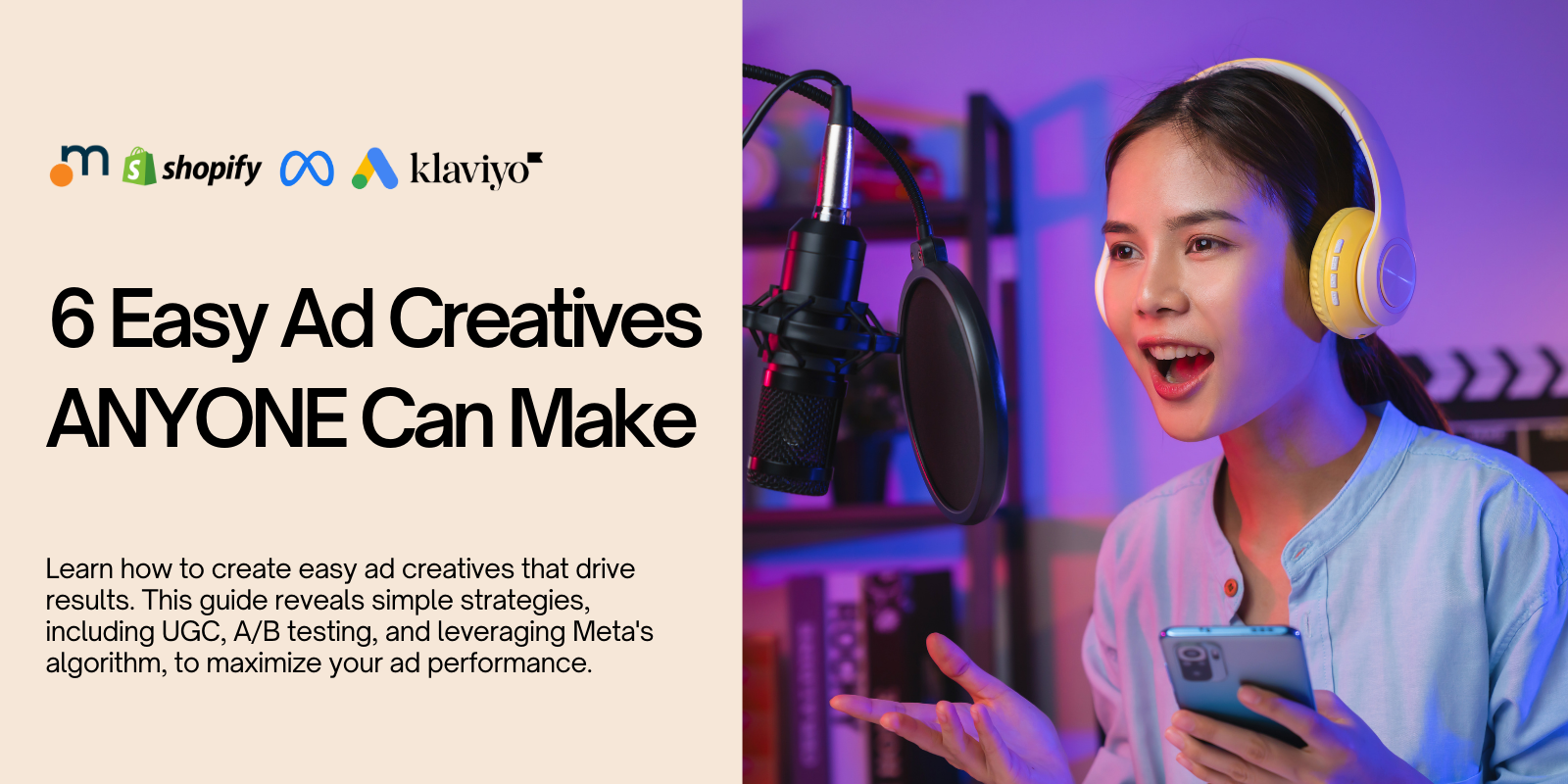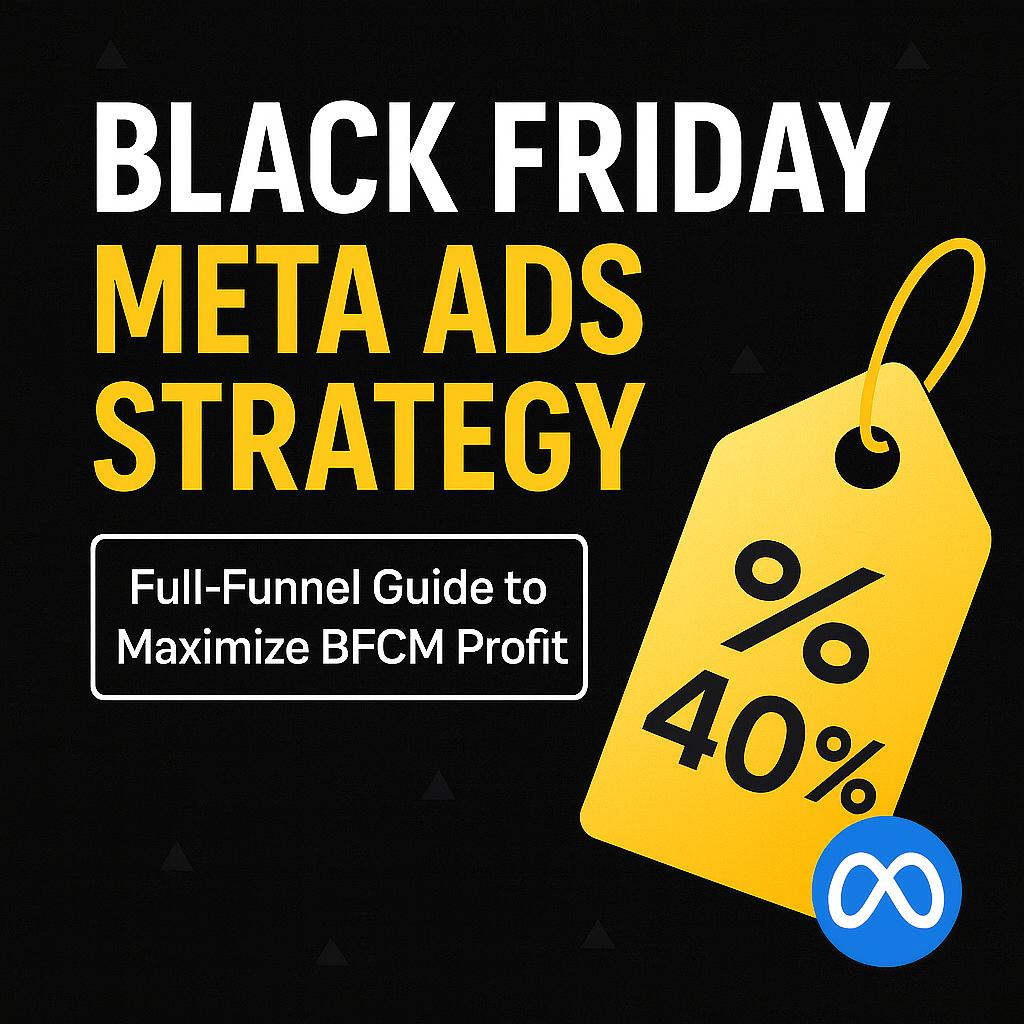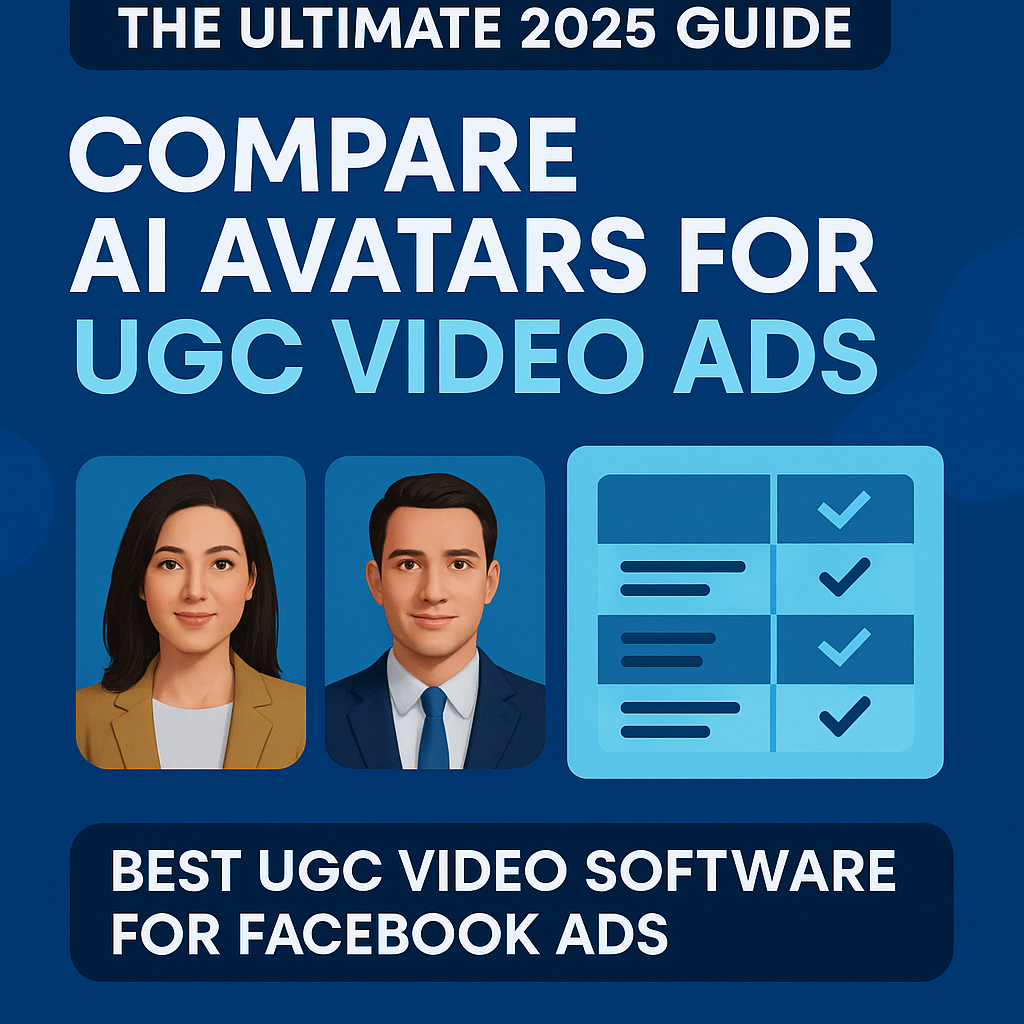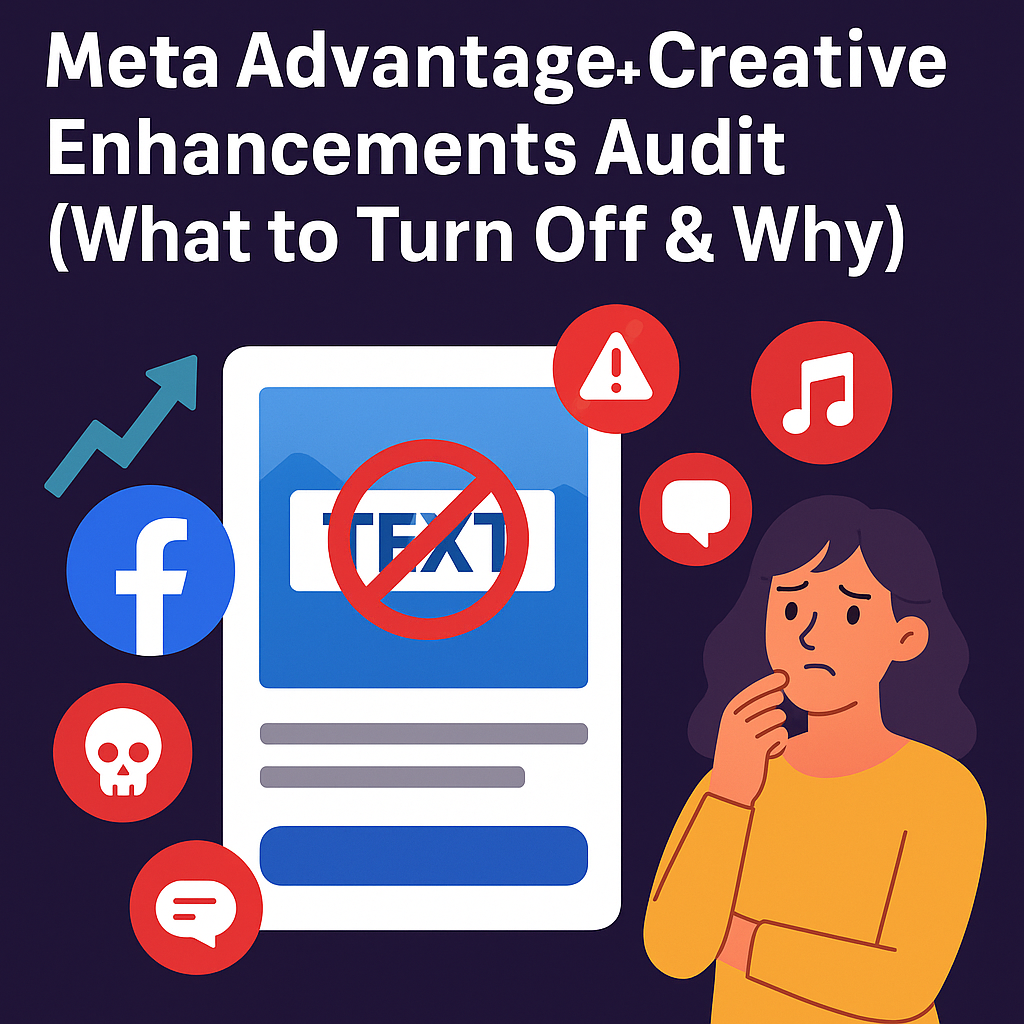Creating easy Facebook ad creatives isn’t a complex or time-consuming process. Whether you’re just starting and looking for Facebook ad creative tips for beginners or you’re seeking new DIY Facebook ad visuals that convert, this practical guide offers a simplified approach to developing ad creatives that resonate with your target audience and provide a strong return on investment (ROI).
We’ll explore six different types of easy Facebook ad creatives you can create and publish in your ad account today. Additionally, we’ll cover key strategies, including leveraging user-generated content (UGC), conducting A/B testing, and utilizing Meta’s algorithms, to help you achieve your advertising goals with ease.
Table of Contents
Understanding “Easy” Facebook Ad Creatives: Focus on Impact, Not Complexity
“Easy” ad creatives refer to visuals that can be produced quickly and cost-effectively using simple tools or existing assets, without sacrificing performance. These creatives allow advertisers to iterate rapidly, test different hooks, and optimize campaigns without getting bogged down in time-consuming production.
6 Easy Facebook Ad Creatives That Convert (With Real Examples)
Here are six highly effective, yet simple, ad creative types designed for quick implementation and instant results on Facebook and Instagram. These formats prioritize authenticity, clarity, and direct user engagement, making them ideal for advertisers seeking to optimize their campaigns with minimal resources.
Easy UGC Facebook Ads: Why They Work + How to Make One
UGC ads use authentic content created by customers or users (photos, videos, or reviews) to create relatable, high-trust ads. They can be developed in-house or sourced through influencer partnerships.
These ads build instant social proof because they feel like recommendations from friends instead of brand promotions. Whether it’s a selfie-style video, a quick testimonial, or an unboxing clip, UGC puts the user experience front and center.
You can easily make UGC content yourself if you are committed to the cause. As someone who likes to test all my angles and hooks relatively quickly, I often shoot UGC content myself to maintain agility and connect directly with my audience.
As someone who personally likes to test all my angles and hooks relatively quickly, I often shoot UGC content myself to maintain agility and directly connect with my audience. Authenticity is king; it builds instant trust and social proof with potential customers on Facebook by feeling genuine and relatable.
I recently created a UGC-style ad that leaned into the idea that solar pricing is often overpriced, positioning our client’s offer as the smarter, more affordable alternative. I conduct thorough competitor research to identify angles competitors are not using and find fresh ways to communicate REAL value. For me, UGC is the fastest way to test hooks, because I shoot the content myself with nothing but a phone and a script in mind. It’s fast, honest, and effective.
Simple Text-Overlay Image Ads:
These ads combine a clear product image with a short, bold text message directly on the visual. Simple text-overlay image ads are easy to create with tools like Canva or Meta’s native ad builder.
This format is ideal when you need to convey your core message fast, especially in a crowded feed. A benefit-driven headline over a relevant image can stop the scroll and deliver your value proposition instantly.

I always start with a headline at the top, then build the layout from scratch based on the product’s USP. While tools like Canva offer quick templates, custom layouts let me highlight messaging more precisely. These ads don’t need fancy design; what matters is that the message is clear and emotionally resonant. I’ve found that a plain background and bold font often outperforms more polished creatives.
Before-and-After/Problem-Solution Visuals:
These visuals show transformation or progress. They are especially powerful in niches like beauty, health, fitness, or cleaning, where outcomes are visually demonstrable.
The contrast between the “before” state (pain point) and the “after” (solution) helps viewers instantly understand the value of your product or service.


The best results I’ve seen with this format come from digging deep into customer pain points, especially through Reddit, reviews, and forums. One early test failed because the headline made a bold claim without sufficient evidence. But reframing it into a question instantly increased relevance and clicks. These visuals work especially well in the beauty industry, where transformation is both visual and emotional.
Poll/Quiz Interactive Ads (Meta Specific):
Leveraging Meta’s built-in interactive features, Poll or Quiz ads allow you to engage your audience directly within the ad unit. These aren’t just for entertainment; they can be powerful tools for audience segmentation, gathering insights, and increasing engagement rates on your easy Facebook ad creatives.
- Easy Tip: Use Meta’s interactive features to ask a simple, relevant question related to your product, a common pain point, or even a brand preference.
- Why it Works: Boosts engagement by inviting direct interaction, and can subtly qualify leads or gather valuable audience insights.

One of our best-performing polls asked: “Do you know your curly hair type?” Not only did it engage, but it helped us segment the audience and build new creative angles based on the responses. Polls are great for sparking curiosity and guiding the direction of future campaigns.
Testimonial/Quote Card/Review Ads:
Testimonial or Quote Card ads visually highlight positive feedback from your customers. These ads turn social proof into a highly impactful and shareable format. They are straightforward to design, making them a perfect example of an easy Facebook ad creative with strong persuasive power.
- Easy Tip: Design a simple, branded graphic featuring a compelling customer quote and, ideally, their photo (with their explicit permission!).
- Why it Works: Provides powerful social proof from trusted sources (your actual customers), building immediate credibility for your brand.



I’ve found that testimonial ads that start with skepticism perform best. They hook readers by reflecting their doubts and then overcoming them with real results. We focus heavily on the testimonial content and let it lead the design. We source publicly posted reviews and only include imagery when it adds trust, not distraction.
Behind-the-Scenes/Process Snippets (Short Video):
Behind-the-scenes or Process Snippet videos offer an authentic glimpse into your brand’s operations, the creation of a product, or a day in the life of your team. These unpolished, raw videos build transparency and create a more personal connection with your audience on Facebook, without requiring high production values.
- Easy Tip: Film a quick, unpolished video using a smartphone showing your product being made, packed, or a glimpse of your team at work.
- Why it Works: Builds transparency, fosters connection with users on a human level, and subtly conveys quality or effort.
Our most successful BTS ad showed the actual people building the product on-site. No script, no lighting, just a phone camera and real moments. We don’t plan these; we just hit record when something worth showing happens. It works because people value transparency, and what works best often depends on what the audience emotionally connects to in that specific industry.
How to Make Easy Facebook Ad Creatives That Actually Win
Creating easy Facebook ad creatives doesn’t mean sacrificing performance. Whether you’re a seasoned marketer or just getting started and searching for Facebook ad creative tips for beginners, this section will walk you through how to build high-performing ad visuals, especially if you’re working with limited resources.
Here are six foundational rules to guide the creation of your DIY Facebook ad visuals that convert:
Rule 1: Stop Doing What Everyone Else Is Doing
Most marketers rely on “pretty” designs with weak or overly clever headlines, and little to no psychological appeal. To create high-converting Facebook ad examples, ditch the over-designed templates and focus on bold clarity. What works:
- Clear, bold headlines
- Simple USP callouts
- Psychology-based layout and contrast
Rule 2: Keep It Simple, Stupid (KISS)
Overcomplicating your creatives is a surefire way to lose attention. In our testing, 90% of winning statics fall into one of these easy formats:
- Comparison ads (e.g., Us vs. Them, Before vs. After)
- Static testimonial ads (lifestyle image + quote)
- Promo ads (simple discount or offer visuals)
Often, these can be combined. The key is to execute the basics well and iterate quickly.
Rule 3: Every Static Has a Hook
Users don’t read ads top to bottom; they scan them in seconds. That’s why DIY Facebook ad visuals must be designed intentionally:
- Use image and headline sizing to guide the eye
- Place emotional or benefit-driven copy in the visual hotspot
- Use font weight, colors, arrows, or text warps to highlight your hook
Rule 4: Assume Nobody Knows (or Cares) About Your Brand
If your ad only makes sense to someone already familiar with your product, it will flop with cold audiences. Use messaging that immediately makes sense without any brand context.
Example:
❌ “I feel human again”
✅ “Natural pain relief for neuropathy”
Your best quick Facebook video ad ideas and statics should pass this test.
Rule 5: Make People Feel Something
Speak to validation, identity, or desire. It’s not about what your product is; it’s about what your customer feels when using it.
❌ “The best summer shirt”
✅ “How she wants your shirt to fit”
Rule 6: Be Clear and Concise
Clarity sells. If your sentence can be rewritten in fewer words, do it. Always ask: Can this message be understood at a glance?
❌ “A men’s polo that’s made for all body types”
✅ “Men’s polos for all body types”
Bonus tip: I often run my copy through GPT to say the same thing in fewer, punchier words. Small copy tweaks = big performance gains.
Apply these rules whether you’re creating your first ad or refining a proven one. These principles are core to every high-converting, beginner-friendly, and quick Facebook ad creative that consistently delivers results.
The Power of User-Generated Content (UGC) for DIY Facebook ads
Authenticity is king in the digital age. Consumers are bombarded with polished, professional advertising, making them increasingly skeptical of traditional marketing messages. This is where user-generated content (UGC) shines. UGC refers to any content, such as photos, videos, or reviews, created by your customers or users, rather than the brand itself. UGC is a goldmine for creating easy ad creatives that feel genuine and relatable.
Why is UGC so effective for Easy Facebook Ad Creatives (Facebook Ad Creative tips for beginners)?
- Trust and Relatability: UGC offers social proof and genuine experiences, building trust with potential customers.
- Diversity: UGC provides diverse perspectives and real-life applications of your product or service.
- Cost-Effectiveness: It’s a budget-friendly alternative to expensive professional photography or videography. You can also explore AI UGC ads to reduce time and costs.
- Increased Engagement: People tend to engage more with content from “real people” who are like themselves.
Sourcing High-Quality UGC for Easy Ad Creatives:
- Influencer Seeding: Send products to influencers in exchange for authentic reviews and content.
- Contests and Giveaways: Encourage user participation by offering incentives for content creation.
- Brand Hashtags: Create a unique hashtag and encourage customers to use it when sharing content related to your brand.
- Customer Reviews: Repurpose positive customer reviews and testimonials in your ads.
Examples of Brands Using UGC for Easy Ad Creatives:
- Airbnb: Showcases user-submitted travel photos, inspiring wanderlust and trust in the platform.
- GoPro: Features user-generated action videos that demonstrate the camera’s capabilities in exciting ways.
- Fashion Brands: Utilize customer outfit posts to showcase their clothing in real-life scenarios.
How to A/B Test Your Facebook Ad Creatives
Data-driven decision-making is crucial for ad creative success. A/B testing allows you to compare different versions of your ads to see which performs best. This eliminates guesswork and ensures you’re investing in creatives that deliver results. If you’re new to advertising or want Facebook ad creative tips for beginners, A/B testing is one of the smartest ways to make your efforts more data-driven and predictable.
Key Elements to Test:
- Headlines: Test different headlines to see which grabs attention most effectively.
- Ad Copy: Experiment with different messaging, calls to action, and tone of voice.
- Visuals: Compare different images or videos to see which resonates best with your audience.
- Call-to-Actions (CTAs): Test different CTA buttons and wording to optimize click-through rates.
- Landing Page: Ensure your landing page aligns with your ad creative and provides a seamless user experience.
Tools and Techniques for Effective A/B Testing:
- Meta Ads Manager: Offers built-in A/B testing features for various ad elements.
- Google Optimize: A free tool that allows you to run A/B tests on your website and landing pages.
- Third-party A/B testing platforms: Provide advanced features and analytics for more in-depth testing.
Analyzing Results and Implementing Changes:
- Statistical Significance: Ensure your results are statistically significant to avoid making changes based on random fluctuations.
- Iterative Testing: Continuously test and refine your creatives based on data and insights.
Leveraging Meta’s Advertising Algorithm
Meta’s algorithm is a powerful tool that can help you reach the right audience with your ads. Understanding how it works is key to optimizing your campaigns for success.
Key Factors Influencing Meta’s Algorithm:
- Relevance: Ensure your ads are relevant to your target audience’s interests and behaviors.
- Engagement: Encourage engagement with your ads through compelling visuals, interactive elements, and clear calls to action.
- User Experience: Provide a positive user experience with relevant landing pages and fast loading times.
- Bid Strategy: Optimize your bidding strategy to ensure your ads are competitive in the auction.
- Budget Allocation: Allocate your budget effectively across different campaigns and ad sets.
Optimizing Your Campaigns for Meta’s Algorithm:
- Clear Messaging: Use concise and compelling language that resonates with your target audience.
- High-Quality Visuals: Use eye-catching visuals that are relevant to your product or service.
- Strong CTAs: Use clear and actionable CTAs that encourage users to take the desired action.
- Landing Page Relevance: Ensure your landing page is relevant to your ad creative and provides a seamless user experience.
- Automated Tools: Utilize Meta’s automated tools and features to optimize your campaigns.
Staying Up-to-Date with Algorithm Changes:
- Follow Meta’s Resources: Stay informed about algorithm updates and best practices through Meta’s official resources.
- Industry Blogs and Experts: Follow industry blogs and experts to stay ahead of the curve.
Diversifying Ad Formats
Experimenting with different ad formats can help you reach a wider audience and achieve different marketing objectives. Whether you’re experimenting with DIY Facebook ad visuals or testing quick Facebook video ad ideas, using multiple ad formats increases your chances of reaching diverse audience segments with different engagement preferences.
Exploring Different Ad Formats:
- Image Ads: Simple and effective for showcasing your product or service.
- Video Ads: Engaging and versatile for storytelling and demonstrating product features.
- Carousel Ads: Allow you to showcase multiple products or features in a single ad.
- Story Ads: An immersive and engaging format for reaching users on mobile devices.
- Interactive Ads: Utilize polls, quizzes, and other interactive elements to increase engagement.
- Augmented Reality (AR) Ads: Offer an innovative and interactive way to showcase your products.
Matching Ad Formats to Campaign Objectives:
- Brand Awareness: Utilize visually appealing formats, such as video and image ads, to enhance brand visibility.
- Direct Response: Use formats with strong CTAs, like carousel ads or collection ads, to drive conversions.
- Consideration Stage: Utilize informative formats, such as carousel ads or video ads, to educate potential customers.
- Purchase Stage: Use retargeting ads with special offers or discounts to encourage conversions.
Examples of Effective Ad Format Combinations:
- Video and Image Ads: Use video ads for storytelling and image ads for retargeting.
- Carousel Ads and Dynamic Creative Optimization: Combine carousel ads with dynamic creative optimization to deliver a personalized ad experience for each user.

Cost Caps and Budget Management
Effective budget management is crucial for maximizing your ad spend and achieving your advertising goals.
Setting Realistic Budget Expectations:
- Align with Business Goals: Determine your advertising budget based on your overall business goals and marketing objectives.
- Industry Benchmarks: Research industry benchmarks and competitor analysis to get an idea of realistic budget expectations.
Utilizing Cost Caps to Control Spending:
- Cost-per-Click (CPC): Set a maximum CPC to control how much you’re willing to pay for each click on your ad.
- Cost-per-Thousand Impressions (CPM): Set a maximum CPM to control how much you’re willing to pay for every 1,000 impressions of your ad.
Monitoring and Adjusting Budgets Based on Performance:
- Analyze Key Metrics: Track key metrics, such as conversion rate, click-through rate (CTR), and return on ad spend (ROAS), to assess campaign performance.
- Identify Areas for Improvement: Analyze the data to pinpoint areas where you can optimize your campaigns and enhance efficiency.
- Reallocate Budget: Shift budget from underperforming campaigns to high-performing ones to maximize ROI.
Scaling Winning Campaigns
Once you’ve identified winning campaigns, it’s time to scale them for increased reach and impact.
Identifying Winning Campaigns:
- Key Performance Indicators (KPIs): Track KPIs like conversion rate, CTR, and ROAS to identify campaigns that are exceeding expectations.
Scaling Strategies for Increased Reach and Impact:
- Expand Targeting: Broaden your targeting parameters to reach a larger audience while maintaining relevance.
- Increase Budget: Gradually allocate a higher budget to high-performing campaigns.
- Creative Variations: Create variations of your winning creatives to combat ad fatigue and maintain engagement.
Maintaining Performance During Scaling:
- Continuous Monitoring: Continuously monitor campaign performance to ensure you maintain or improve results as you scale.
- Avoid Audience Fatigue: Introduce new creatives and refresh your messaging to prevent audience fatigue.

FAQs
What is the best Facebook ad format for my business?
The best ad format depends on your business objectives and the stage of the customer journey you’re targeting. For brand awareness, video and image ads work well. The most underrated Facebook Ad is the simple text image style because it is low-effort, easy, and quick to create.
How much should I spend on Facebook advertising?
Your advertising budget should align with your overall business goals and expected ROI. A common starting point is allocating 5–10% of monthly revenue. Consider how aggressive your growth targets are, what your competitors are spending, and test budgets across different campaign types (top, mid, and bottom funnel). Monitor your performance metrics and shift budgets to high-performing ad sets or creatives.
How long does it take to see results from my Faebook ads?
Typically, you’ll start to see early performance indicators (like impressions, CTR, and engagement) within the first 3 days. However, for conversion-focused results, allow 5–7 days for Meta’s algorithm to complete the learning phase. Be patient and avoid making major changes too soon, as premature edits can reset the optimization window.
How can I improve my Facebook ad targeting?
Leverage Meta’s detailed targeting options, including demographics, interests, behaviors, and location. Use Lookalike Audiences based on your highest-value customers or website visitors. Combine targeting with A/B testing to refine your segments. Also, don’t overlook custom audiences for retargeting and dynamic creative to personalize your message.
What are some common mistakes to avoid in Facebook ad creative?
Avoid using overly polished or generic visuals that feel disconnected from your audience. Weak headlines, unclear messaging, and poor CTAs are also common pitfalls. Ensure your creative aligns with the offer, is designed for mobile viewing, and loads quickly. Always match the landing page experience with the promise of the ad to maintain continuity and trust. Creating easy Facebook ad creatives doesn’t have to be overwhelming. Use the six formats above to generate scroll-stopping visuals fast. With UGC, smart testing, and Meta’s powerful tools, you can launch campaigns that drive results without spending weeks in production. Stay agile, track performance, and iterate quickly to maximize your ad ROI.
Conclusion
Creating easy Facebook ad creatives doesn’t have to be overwhelming. Whether you’re testing quick Facebook video ad ideas, building out DIY Facebook ad visuals, or looking for high-converting Facebook ad examples, the six formats above will help you generate scroll-stopping ads fast.
The beauty of these ad formats is that they’re not just simple, they’re proven. They work because they speak directly to what your audience wants: relevance, clarity, and authenticity. You don’t need a big budget or a fancy production team to make an impact. You need a clever hook, a relatable message, and a design that catches attention.
Remember, even the best ideas won’t win without testing. A/B test relentlessly, pay attention to early indicators like CTR and engagement, and let the data lead your creative evolution. Your first draft doesn’t need to be perfect; your best-performing ad might come from the simplest version you least expected.
So take action. Use this guide to create your next batch of ad creatives. Test them, learn from the results, and keep refining. The faster you iterate, the quicker you grow.
Because at the end of the day, the secret to success with Facebook ads isn’t complexity, it’s consistency, clarity, and creativity backed by data.





